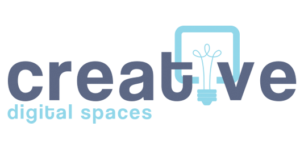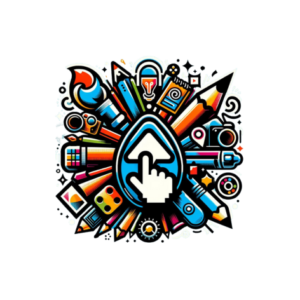
How to set it up?
Hosting creative processes online poses a unique challenge, as the absence of physical presence disrupts the natural flow of collaborative energy. Creativity often thrives in the spontaneity of face-to-face interactions, making it challenging to replicate that synergy through digital mediums. Breaking down this virtual barrier requires intentional efforts to foster a sense of connection and shared purpose. Incorporating icebreaker activities, virtual team-building exercises, and dedicated time for informal conversations can serve as the proverbial spark, warming up the online environment and encouraging the free flow of creative ideas.
There are some activities that could support us in sparking creativity:
Alternate Uses Brainstorm
Set the timer for three minutes and have participants pick an everyday object. Challenge them to generate as many alternate uses for that object as possible. This not only stimulates divergent thinking but also encourages participants to view everyday items through a creative lens. After the timer expires, participants can share their most innovative ideas, fostering a collaborative and open-minded atmosphere.
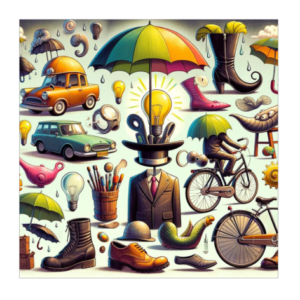 Bad Ideas Exploration
Bad Ideas Exploration
Form small groups and assign each group an objectively lousy idea, such as “Sandpaper Socks” or “Ketchup-flavored Popsicles.” Task them with discussing potential benefits, uses, and selling points for their assigned lousy idea. This exercise challenges participants to think beyond initial judgments and explore the positive aspects of unconventional concepts. By presenting their findings to the larger group, teams can collectively embrace a mindset focused on possibilities rather than limitations.
The Expert Challenge
Designate one person as “the expert” and have the rest of the group shout out two unrelated nouns. Combine these nouns into a new “product,” such as a “sneaker table” or “table sneaker.” The assigned expert must then creatively sell the team on the benefits and features of this unconventional product. This activity not only sparks imaginative thinking but also encourages participants to find value in unexpected combinations, fostering a mindset of open exploration.
What are good practice examples?
1.) GIMP
is a powerful open-source image editing software that rivals many premium tools. It offers a wide range of features for photo retouching, image editing, and graphic design.
It can be used to empower young people to enhance their visual communication skills by organizing GIMP workshops. Encourage them to create eye-catching posters, infographics, or social media content for youth initiatives. This hands-on experience with graphic design can foster creativity and provide valuable digital skills.
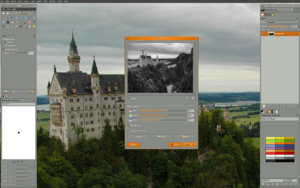
2.) Animoto
is a user-friendly video creation tool that allows us to turn photos, video clips, and music into professional-looking videos. It’s perfect for storytelling and dynamic visual presentations.
It can help us to engage youth in multimedia storytelling projects. Whether documenting community events or sharing personal narratives, Animoto can help them convey impactful messages. This collaborative activity enhances digital storytelling skills and encourages teamwork.
3.) Genially
is an interactive content creation platform enabling the design of presentations, infographics, and interactive images. It offers a diverse range of templates and customization options.
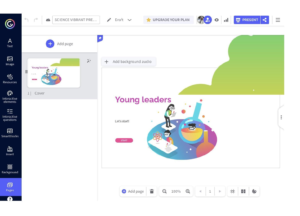 This tool can be used to create visually engaging presentations or infographics for community projects. With this tool, we can communicate ideas effectively and make information more accessible and engaging for peers. It also offers gamification possibilities, from virtual escape rooms to drag-and-drop puzzles. The benefit of game-based content is to enhance learning outcomes. With Genially, you can also prepare more complex products like digital magazines. You can find the example here.
This tool can be used to create visually engaging presentations or infographics for community projects. With this tool, we can communicate ideas effectively and make information more accessible and engaging for peers. It also offers gamification possibilities, from virtual escape rooms to drag-and-drop puzzles. The benefit of game-based content is to enhance learning outcomes. With Genially, you can also prepare more complex products like digital magazines. You can find the example here.
4.) Pixton
is an online platform for creating comics. With a user-friendly interface and a vast library of characters, backgrounds, and props, it’s an ideal tool for expressing ideas through visual storytelling.
We can use it to work with groups to express their thoughts, ideas, or even complex concepts through comics. This visual medium not only develops their creative expression but also provides a fun and unique way to address social issues or share perspectives within the group.
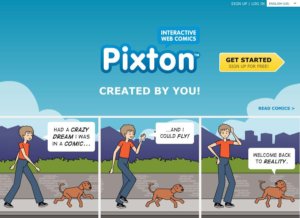
5.) Powtoon
is an animated video creation platform that simplifies the process of making engaging and professional-looking animated videos. It’s perfect for conveying information in a visually captivating way.
It supports group members to create animated presentations on essential topics or to showcase their projects. Powtoon adds a creative flair to their communication skills and enables them to deliver impactful messages through animated storytelling.
6.) Storyboard That
is an online platform that allows us to create storyboards and visual narratives using a simple drag-and-drop interface. With a vast library of customizable characters, scenes, and props, it enables individuals to craft detailed and professional-looking storyboards easily. The tool provides templates for various purposes like education, business, or personal storytelling, fostering creativity and efficient communication of ideas. It offers both free and premium subscription options, granting access to additional features and higher-resolution downloads. Storyboard enable us to visually map out our narratives, presentations, or lesson plans flexibly and efficiently, making it a valuable tool for storytelling and visual communication.
Do you want to avoid using digital tools? With your group, you can try analog meme creation activity!
Meme creation can be a fun and engaging activity for youth work, even if you don’t have access to any online tools or software. With some creativity and basic materials, participants can create memes using analog equipment found at home. Here’s how to get started:
Goals: Clearly define the goals of the activity. Are you looking to teach specific meme-creation techniques? Are you trying to foster a sense of community and shared experience through meme creation? Having clear goals will help you plan and structure the activity effectively. One example of the task could be creating a meme of something participants fear or have a phobia about. The text can ridicule those fears and create humorous collusion for the encounter with them.
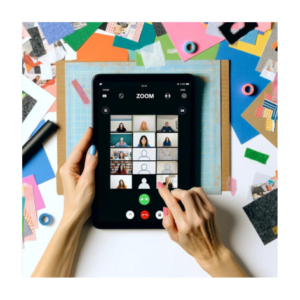 Gather materials: Participants will need some basic materials to get started, such as paper, pens or pencils, and any other drawing or crafting tools they have on hand. They may also want to have some books or magazines available for reference.
Gather materials: Participants will need some basic materials to get started, such as paper, pens or pencils, and any other drawing or crafting tools they have on hand. They may also want to have some books or magazines available for reference.
Choose a theme: Decide on a theme for the activity, such as a current event, a popular meme format, or a particular topic of interest. This will give participants a focus for their creations.
Create the memes: Using their materials, participants can draw, write, or collage their memes. Encourage them to be creative and have fun with the process!
Share the memes: Once everyone has finished creating them, you can use a video call to share and discuss the results. Encourage participants to explain their creations and talk about what inspired them.
Optional: If you want to take the activity a step further, consider having participants take photos of their memes and share them online. Just be sure to follow all necessary safety guidelines when doing so.
It’s important to remember the power of meme creation as a tool for connecting with young people. Not only can these creative outlets provide a sense of accomplishment and self-expression, but they can also serve as a way to foster a sense of community and shared experience. In the fast-paced world of the internet, humor and meme culture provide a way for young people to connect on a deeper level.
